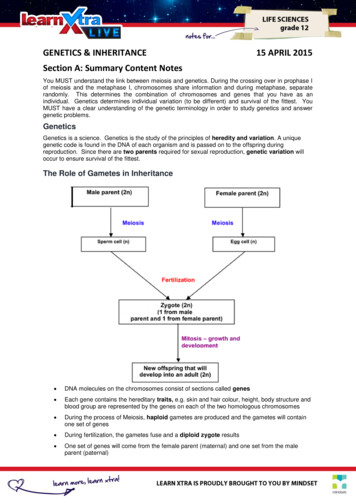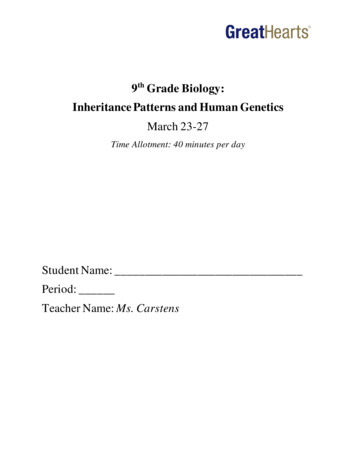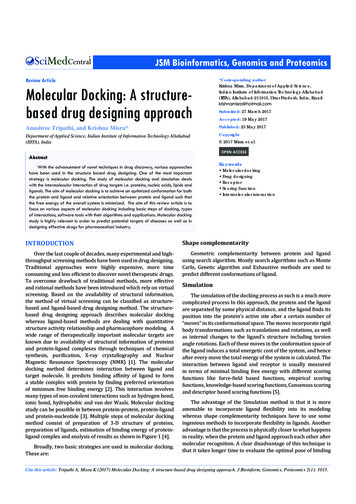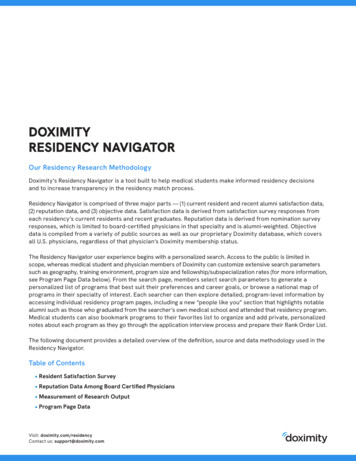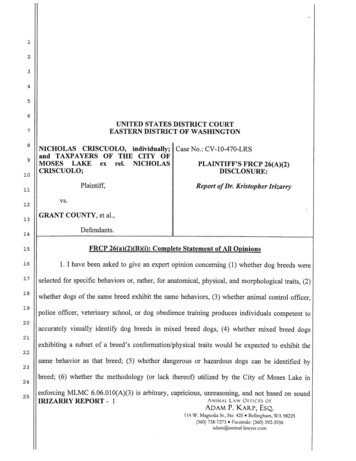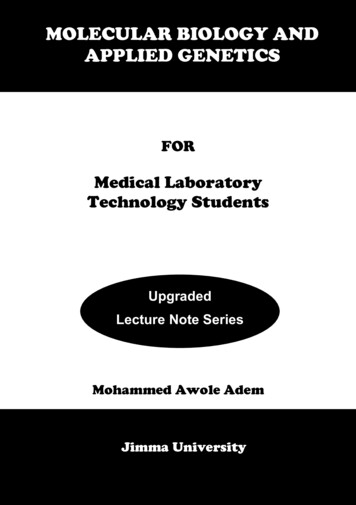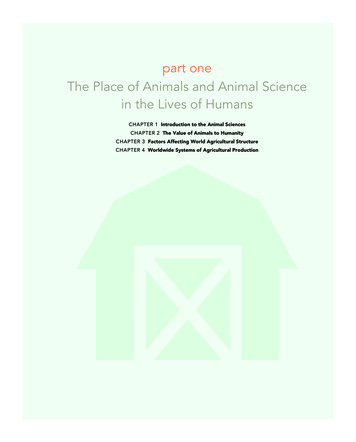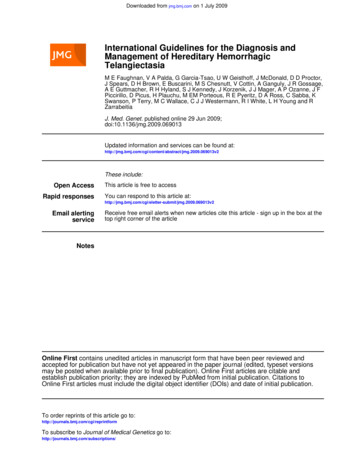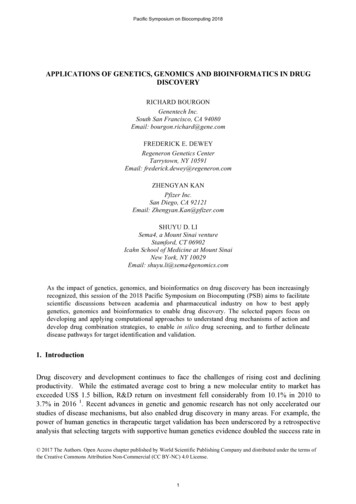
Transcription
Pacific Symposium on Biocomputing 2018APPLICATIONS OF GENETICS, GENOMICS AND BIOINFORMATICS IN DRUGDISCOVERYRICHARD BOURGONGenentech Inc.South San Francisco, CA 94080Email: bourgon.richard@gene.comFREDERICK E. DEWEYRegeneron Genetics CenterTarrytown, NY 10591Email: frederick.dewey@regeneron.comZHENGYAN KANPfizer Inc.San Diego, CA 92121Email: Zhengyan.Kan@pfizer.comSHUYU D. LISema4, a Mount Sinai ventureStamford, CT 06902Icahn School of Medicine at Mount SinaiNew York, NY 10029Email: shuyu.li@sema4genomics.comAs the impact of genetics, genomics, and bioinformatics on drug discovery has been increasinglyrecognized, this session of the 2018 Pacific Symposium on Biocomputing (PSB) aims to facilitatescientific discussions between academia and pharmaceutical industry on how to best applygenetics, genomics and bioinformatics to enable drug discovery. The selected papers focus ondeveloping and applying computational approaches to understand drug mechanisms of action anddevelop drug combination strategies, to enable in silico drug screening, and to further delineatedisease pathways for target identification and validation.1. IntroductionDrug discovery and development continues to face the challenges of rising cost and decliningproductivity. While the estimated average cost to bring a new molecular entity to market hasexceeded US 1.5 billion, R&D return on investment fell considerably from 10.1% in 2010 to3.7% in 2016 1. Recent advances in genetic and genomic research has not only accelerated ourstudies of disease mechanisms, but also enabled drug discovery in many areas. For example, thepower of human genetics in therapeutic target validation has been underscored by a retrospectiveanalysis that selecting targets with supportive human genetics evidence doubled the success rate in 2017 The Authors. Open Access chapter published by World Scientific Publishing Company and distributed under the terms ofthe Creative Commons Attribution Non-Commercial (CC BY-NC) 4.0 License.1
Pacific Symposium on Biocomputing 2018clinical development 2. A recent report on the clinical impact of loss-of-function (LoF) geneticvariants in 50,726 exomes confirmed previously known associations between genes such asPCSK9 and cardiovascular disease-related phenotypic traits, and identified novel associations withtherapeutic implications 3. Genomics and genetics also play an increasingly important role in otherareas in drug discovery such as biomarker identification for drug efficacy 4 and safety 5,understanding drug mechanisms of action 6, and selecting disease relevant experimental models 7.To facilitate the application of genomics in drug discovery, data quality and reproducibility havebeen systematically assessed 8 to increase our confidence on findings from pharmacogenomicstudies. Furthermore, new methods and tools have been developed for integrative genomic dataanalysis 9.Although the impact of genetics, genomics and bioinformatics in drug discovery has beenrecognized by both academia and pharmaceutical industry, the coverage of the topic in scientificconferences is very limited. The main objective of this session “Applications of genetics,genomics and bioinformatics in drug discovery” in the 2018 PSB is to cover recent advances indeveloping and applying computational approaches to enable drug discovery in the abovedescribed areas. Furthermore, the session is also intended to promote more interactions andcollaborations between academic and industry experts. We believe such a session dedicated tobioinformatics in the context of drug discovery could significantly benefit academic preclinicaldrug discovery activities, as a large number of academic drug discovery centers have beenestablished in recent years 10. We define the following topics and problems are within the scope ofthis session. Target identification and validation: integrative analysis of molecular data at scale, couplinggenetic, epigenetic, gene expression profiling, proteomic, metabolomic, phenotypic traitmeasurements to disease diagnosis and clinical outcome data to generate hypotheses onmolecular etiology of diseases in service of identification or validation of novel therapeutictargets.Biomarker discovery: utilizing genetic and genomic data derived from cell lines, animalmodels, human disease tissues and PBMC to develop preclinical or clinical biomarkers fortarget engagement, pharmacodynamics, drug response, prognosis, and patient stratification;applying genomic profiling in clinical trials to identify early response markers to predictclinical end points.Pharmacogenomics: identify associations between germline SNPs, somatic mutations, geneexpression and other molecular alterations and drug responses.Toxicogenomics: integrative analysis of genomic, histopathology, and clinical chemistry datato develop predictive toxicology biomarkers in preclinical 4-day, 14-day and 30-day studiesand clinical studies.Understanding drug mechanisms of action (MoA): applying genomic profiling to de-convolutetargets and delineate MoA of non-selective drugs or drugs from phenotypic screening.Characterization of mechanisms of acquired resistance: analysis of genetic and genomic dataderived from preclinical isogenic models or clinical patient samples to study the mechanismsof acquired resistance.2
Pacific Symposium on Biocomputing 2018 Selection of disease-relevant experimental models: comparative analysis of genetic andgenomic data to assess and select cell line and animal models in drug discovery that bestrepresent the disease indications.Developing drug combination strategies: analysis of genetic and genomic data to identifysynthetic lethality genes as drug combination targets; computational analysis to understandgene regulatory networks to develop combination strategies that target parallel pathways orreverse drug resistance.Drug repurposing: applying in silico approaches to identify new disease indications forexisting drugs.Novel methods and tools for multi-omics data integration, analyses, and visualization.2. Session ContributionsA total of eight papers were selected from the submissions. We categorized the eight papers intothe following three groups. The papers in the first group focus on drug mechanisms of action anddrug combinations. The second group includes studies that can be applied to enable computationaldrug screening. The papers in the third group apply various computational approaches on geneticand genomic data to further understand diseases.2.1. Drug mechanisms of action and drug combinationsUnderstanding drug mechanisms of action is critical in clinical development and precisionmedicine, particularly in identifying early response markers as surrogates for clinical end-point aswell as biomarkers for patient stratification. In addition, a better knowledge of MoA may allow usto reposition the existing drugs for new indications. In the study by Luo et al. 11, the authorsdeveloped a novel method, referred as Mania, for scalable data integration incorporating chemicalstructure, drug sensitivity and gene expression changes in response to drug treatment. Drugsimilarity networks were first constructed based on each of these data sources, followed byintegration through Mania into a low-dimensional vector representation of each drug. It wasshown that integration of various data sources improves quantification of drug-drug similarities,and achieves more accurate prediction of drug targets and MoA. Functionally enriched “drugcommunities”, as referred by the study, was also identified using the low-dimensional vectorrepresentation matrix. Finally, the authors illustrated potential utilities of their new method byanalyzing the most significantly mutated genes across 21 tumor types in the cancer genome atlas(TCGA) and presented examples of drugs that are predicted to target some of the significantlymutated cancer genes.Gene expression profiling in cell lines in response to drug perturbation has provided a valuabletool to study drug MoA. Although a large number of drugs have been profiled in many cancer celllines of various tissue origins, there are still substantial missing drug-cell line combinations inthese data sources. Hodos et al. 12 attempted to fill the gaps by predicting cell specific drugperturbation expression profiles. The authors developed a computational framework to firstarrange existing gene expression profiles into a three-dimensional array (or tensor) indexed bydrugs, genes, and cell types, and then use either local (nearest-neighbors) or global (tensor3
Pacific Symposium on Biocomputing 2018completion) information to predict unmeasured profiles. The prediction accuracy was thoroughlyevaluated and it was found that the two methods (local vs. global) have complementaryperformance, each superior in different regions in the drug-cell space. Finally, the authorsdemonstrated that the predicted profiles add value for downstream prediction of drug targets andtherapeutic classes. For example, it was shown the classifiers trained on the complete dataset areof higher quality than those trained only on the measured dataset, with particularly significantimpact on those cell types with fewer measured profiles available.Drug treatment may induce alternative splicing as a key response event with functionalconsequences. However, limitation of short-read sequencing poses a barrier to accurately detectdifferent splicing isoforms. Chen et al. 13 described characterization of the transcriptional splicinglandscape in a prostate cancer cell line treated with a previously identified synergistic drugcombination, by using a combination of third generation long-read RNA sequencing technologyand short-read RNA-seq to create a high-fidelity map of expressed isoforms and fusions toquantify splicing events triggered by treatment. The authors found strong evidence for druginduced, coherent splicing changes that disrupt the function of oncogenic proteins, and detectednovel transcripts arising from previously unreported fusion events. The study demonstrated thebenefit of long-read technology in identifying highly homologous isoforms routinely and withhigh fidelity.Most patients with advanced cancers ultimately develop drug resistance to chemotherapy ortargeted therapy due to reactivation of the same pathway or compensatory pathways. Combinationtherapy targets multiple pathways, therefore may improve efficacy and also overcome drugresistance in some cases. Xu et al. 14 presented a novel computational approach to predictcombinations through assessing the potential impact of inhibiting a drug target on diseasesignaling network. Using melanoma as an example to apply the approach, the authors firstconstructed a disease network by integrating gene expression profiling and protein-proteininteraction data. A drug-disease “impact matrix” was computed using network diffusion distancefrom drug targets to signaling network elements. The drugs were then clustered into“communities” that are supposed to share similar mechanisms of action. Finally, drugcombinations maximally impacting signaling sub-networks are ranked and proposed as potentialcombination strategies for melanoma.2.2. Drug metabolism and in silico drug screeningHuman gut bacteria have the ability to activate, deactivate, and reactivate drugs with hugeimplications in drug efficacy and toxicity at individual patient level. Understanding the completespace of drug metabolism by the human gut microbiome is critical for predicting bacteria-drugrelationships and their effects on drug response. To address the challenge that there are limitedcomputational tools for predicting drug metabolism by the gut microbiome, Mallory et al. 15developed a pipeline for comparing and characterizing chemical transformations using continuousvector representations of molecular structure based on unsupervised learning, and characterizedthe utility of vector representations for chemical reaction transformations. After clusteringmolecular and reaction vectors, enriched enzyme names, Gene Ontology terms, and Enzyme4
Pacific Symposium on Biocomputing 2018Consortium (EC) classes were detected within the reaction clusters. Finally the authors queriedreactions against drug-metabolite transformations known to be metabolized by the human gutmicrobiome, and showed the top results for these known drug transformations contained similarsubstructure modifications to the original drug pair. The method described in this study could bepotentially applied in high throughput screening of drugs and their resulting metabolites againstchemical reactions common to gut bacteria.The study by Greenside et al. 16 addresses a critical component in drug discovery,identification of small molecule ligands that bind to the target proteins as a first step in drugscreening. While the currently available computational tools for predicting protein-ligand bindinglargely rely on 3D protein structure, this study described an interpretable confidence-ratedboosting algorithm to predict protein-ligand interactions with high accuracy from ligand chemicalsubstructures and protein 1D sequence motifs, without relying on 3D protein structures. Theauthors showed that their models can be generalized to unseen proteins and ligands, demonstratingthe possibility to predict protein-ligand interactions using only motif-based features and thatinterpretation of these features can reveal new insights into the molecular mechanics underlyingeach interaction.2.3. Disease genes and pathwaysNovel computational approaches have been continuously developed and applied to analyze geneticand genomic data. Recently, deep learning has emerged as a novel class of machine leaningmethods. While deep learning has been applied in many domains such as speech recognition,image recognition, natural language processing, its application in analyzing genomic data is verylimited. Way et al. 17 applied variational autoencoders (VAEs), an unsupervised deep neuralnetwork approach to analyze TCGA gene expression profiling data. Specifically, the extent towhich a VAE can be trained to model cancer gene expression, and whether or not such a VAEwould capture biologically relevant features were evaluated. The paper introduced a VAE trainedon TCGA pan-cancer RNA-seq data, identified specific patterns in the VAE encoded features, anddiscussed potential merits of the approach. To illustrate the utility of VAEs in further delineatingcancers, the authors described examples from their analyses on significant pathways separatingprimary and metastatic melanoma, and on pathways over-represented in different subtypes ofhigh-grade serous ovarian cancer.Human genetic data based on genome-wide sequencing or genotyping, coupled with hospitalelectronic medical records (EMRs) have provided a powerful tool to study the genetic basis ofhuman diseases. Smith et al. 18 described integrative analysis of genetic data derived from DNAsamples in a biobank and the accompanying clinical diagnosis information in EMRs to identifyseveral neuroplasticity genes associated with neurodevelopmental diseases. The authors firstdeveloped a neuroplasticity gene signature from two independent gene expression profilingdatasets. Subsequently, carriers of loss-of-function (LoF) genetic variants in the neuroplasticitygenes were identified in the biobank cohort. The authors then performed an association analysis todiscover significant associations between LoF in neuroplasticity genes and neurodevelopmental5
Pacific Symposium on Biocomputing 2018diseases. Finally, a thorough literature review was described to demonstrate the validity of theresults.3. AcknowledgmentsWe thank our respective organizations for supporting our involvement in organizing the session.We also thank the following reviewers for providing expert reviews of the submitted manuscripts:Vinayagam Arunachalam, Kristin Ayer, Ronghua Chen, Keith Ching, Ying Ding, Di Feng, JulioFernandez, Marc Fink, Rajarshi Guha, Yangyang Hao, Jon Hill, Kipp Johnson, Robert Kueffner,Samir Lal, Hai Lin, Meng Ma, Gianni Panagiotou, Chetanya Pandya, Kiran Patil, Jeff Sutherland,Alex Tropsha, Song Wu, Tao Xie, Kun Yu, Yong Yue, Baohong Zhang, Chi Zhang, Yan Zhang,Xiaotong Zhu, Daniel Ziemek.References1. Mullard, A. R&D returns continue to fall. Nature reviews. Drug discovery 16, 9 (2016).2. Nelson, M.R. et al. The support of human genetic evidence for approved drug indications.Nature genetics 47, 856-860 (2015).3. Dewey, F.E. et al. Distribution and clinical impact of functional variants in 50,726 wholeexome sequences from the DiscovEHR study. Science (New York, N.Y.) 354 (2016).4. Kelloff, G.J. & Sigman, C.C. Cancer biomarkers: selecting the right drug for the right patient.Nature reviews. Drug discovery 11, 201-214 (2012).5. Khan, S.R., Baghdasarian, A., Fahlman, R.P., Michail, K. & Siraki, A.G. Current status andfuture prospects of toxicogenomics in drug discovery. Drug discovery today 19, 562-578(2014).6. Nijman, S.M. Functional genomics to uncover drug mechanism of action. Nature chemicalbiology 11, 942-948 (2015).7. Horvath, P. et al. Screening out irrelevant cell-based models of disease. Nature reviews. Drugdiscovery 15, 751-769 (2016).8. Haverty, P.M. et al. Reproducible pharmacogenomic profiling of cancer cell line panels.Nature 533, 333-337 (2016).9. Fernandez-Banet, J. et al. OASIS: web-based platform for exploring cancer multi-omics data.Nature methods 13, 9-10 (2016).10. Dahlin, J.L., Inglese, J. & Walters, M.A. Mitigating risk in academic preclinical drugdiscovery. Nature reviews. Drug discovery 14, 279-294 (2015).11. Luo, Y., Wang, S., Xiao, J. & Peng, J. Large-Scale Integration of HeterogeneousPharmacogenomic Data for Identifying Drug Mechanism of Action. Pacific Symposium onBiocomputing 23 (2017).12. Hodos, R. et al. Cell-specific prediction and application of drug-induced gene expressionprofiles. Pacific Symposium on Biocomputing 23 (2017).13. Chen, X. et al. Characterization of drug-induced splicing complexity in prostate cancer cellline using long read technology. Pacific Symposium on Biocomputing 23 (2017).14. Xu, J. et al. Diffusion Mapping of Drug Targets on Disease Signaling Network ElementsReveals Drug Combination Strategies. Pacific Symposium on Biocomputing 23 (2017).6
Pacific Symposium on Biocomputing 201815. Mallory, E.K., Acharya, A., Rensi, S.E., Bright, R.A. & Altman, R.B. Chemical reactionvector embeddings: towards predicting drug metabolism in the human gut microbiome. PacificSymposium on Biocomputing 23 (2017).16. Greenside, P., Hillenmeyer, M. & Kundaje, A. Prediction of protein-ligand interactions frompaired protein sequence motifs and ligand substructures. Pacific Symposium on Biocomputing23 (2017).17. Way, G.P. & Greene, C.S. Extracting a Biologically Relevant Latent Space from CancerTranscriptomes with Variational Autoencoders. Pacific Symposium on Biocomputing 23(2017).18. Smith, M.R. et al. Loss-of-function of Neuroplasticity-related genes confers risk for humanneurodevelopmental disorders. Pacific Symposium on Biocomputing 23 (2017).7
bioinformatics in the context of drug discovery could significantly benefit academic preclinical drug discovery activities, as a large number of academic drug discovery centers have been established in recent years 10. We define th
